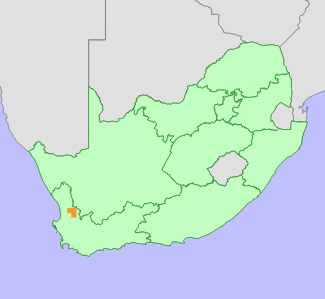|
Scientific Name | Leucospermum reflexum H.Buek ex Meisn. |
Higher Classification | Dicotyledons |
Family | PROTEACEAE |
Common Names | Rocket Pincushion (e) |
National Status |
Status and Criteria | Near Threatened D2 |
Assessment Date | 2019/09/12 |
Assessor(s) | A.G. Rebelo, H. Mtshali & L. von Staden |
Justification | Leucospermum reflexum is a range-restricted species, with an extent of occurrence (EOO) of 641 km², and an area of occupancy (AOO) of 164 km², and it is known from 8-10 locations. All locations outside of the Cederberg Wilderness Area are potentially threatened by expansion of rooibos tea cultivation. As a seepage specialist, it is also vulnerable to the impacts of drought and the predicted aridification of its habitat in response to Climate Change. |
Distribution |
Endemism | South African endemic |
Provincial distribution | Western Cape |
Range | This species has a limited distribution range in the Western Cape Province of South Africa, occurring in the northern Cederberg Mountains. |
Habitat and Ecology |
Major system | Terrestrial |
Major habitats | Cederberg Sandstone Fynbos |
Description | It occurs near streamsides in sandstone fynbos, 450-1200 m. Mature individuals are killed by fires, and only seeds survive. Seeds are released after ripening, and dispersed by ants to their underground nests, where they are protected from predation and fire. It is pollinated by birds. |
Threats |
| Drainage of wetlands and drought related mortality have been observed in the past, but are not currently ongoing. Although most of this species' habitat is protected, 3% has been lost to agriculture in the past. The remaining habitat outside the protected areas is potentially threatened by expanding rooibos tea plantations; and by habitat degradation from too frequent fires and alien invasive species. Global climate change is likely to be a threat. |
Population |
Leucospermum reflexum occur in discrete, isolated stands of several hundreds plants. There are 15 to 20 subpopulations known from between eight to ten locations. As there are potential threats to this species the population is not suspected to be declining.
|
Population trend | Stable |
Conservation |
| Some 60% of this species population is protected within the Cedarberg Wilderness Area. |
Assessment History |
Taxon assessed |
Status and Criteria |
Citation/Red List version | | Leucospermum reflexum H.Buek ex Meisn. | NT D2 | Raimondo et al. (2009) | |
Bibliography |
Goldblatt, P. and Manning, J.C. 2000. Cape Plants: A conspectus of the Cape Flora of South Africa. Strelitzia 9. National Botanical Institute, Cape Town.
Raimondo, D., von Staden, L., Foden, W., Victor, J.E., Helme, N.A., Turner, R.C., Kamundi, D.A. and Manyama, P.A. 2009. Red List of South African Plants. Strelitzia 25. South African National Biodiversity Institute, Pretoria.
Rebelo, T. 2001. Sasol Proteas: A field guide to the proteas of southern Africa. (2nd ed.). Fernwood Press, Vlaeberg, Cape Town.
|
Citation |
| Rebelo, A.G., Mtshali, H. & von Staden, L. 2019. Leucospermum reflexum H.Buek ex Meisn. National Assessment: Red List of South African Plants version . Accessed on 2025/07/06 |
 Comment on this assessment
Comment on this assessment

